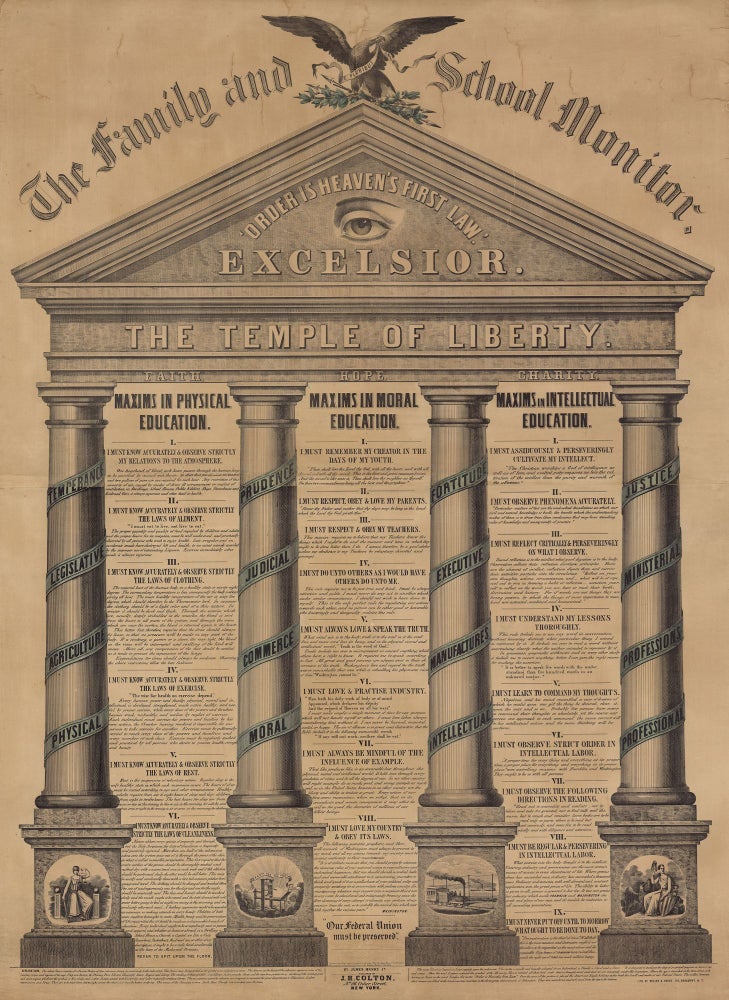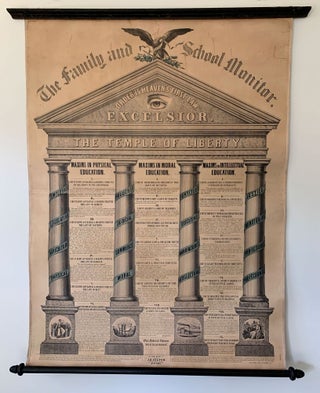The Family and School Monitor.
New York: Published by J. H. Colton, No. 86 Cedar Street, 1847. Lith. of Miller & Boyle, 102 Broadway. Hand-colored lithograph on two joined sheets, 41” x 31.25”, mounted on recently renewed linen and attached to wooden rods. A very scarce wall chart designed to instill in youth a host of maxims in the categories of physical, moral, and intellectual education, published by J. H. Colton, best known as one of the leading nineteenth century publishers of maps and atlases. The chart combines instructive text and symbolic vignettes with classical architecture to create a sense of order and rectitude. Extending across the bottom is a detailed explanation of its various elements:
The above Chart consists of a Tuscan Portico of four columns drawn in conformity to the rules of art. This portico may be regarded as the symbol of an enlightened state. The figures at the bases of the columns represent some of the leading ideas and agents of the age. They are Justice, the Printing Press, Electric Telegraph, Steam Engine and Liberty. The reading of these symbols is as follows: Justice precedes liberty and the steps from justice to liberty are through the printing press and steam engine, which are the symbols of Knowledge and Labor. Justice united with knowledge and labor, naturally produces liberty. The inscriptions upon the columns are designed to represent the great departments in Education, Labor, Government and Virtue. They are to be read from left to right across the chart and from the bottom to the top. The names of the Christian virtues Faith, Hope, Charity are inscribed upon the frieze. The motto “Excelsior” appears in large capitals upon the pediment. The motto is equally and happily adapted for an Individual, a Family, a School, and a State. It is designed to inculcate the duty of perpetual progress in knowledge and virtue. Above the word Excelsior is placed the symbol of the All seeing Eye, to remind all that God seeth: that in thought, word and deed we are constantly under His inspection. Above the eye is inscribed in the form of an arch having its basis on the word Excelsior the motto “Order is Heaven’s first Law.” Over the apex of the portico is placed the American Eagle holding in his beak the Scroll and motto of our Federal Union. The tables between the columns are filled with fundamental maxims in the three great departments of Education. They are numbered and to be read from the top to the bottom.
Some of the more interesting maxims appear in the column devoted to Physical Education. These include such nuggets as: “I must know accurately & observe strictly my relations to the atmosphere. One hogs head of blood, each hour, passes through the human lungs to be purified by contact with the air. To effect that purification one hundred and two gallons of pure air are required each hour…” Also, “I must know & accurately observe strictly the laws of clothing…through the arteries which are, usually, deeply embedded in the muscles, the blood is sent from the heart to all parts of the system, and through the veins which are near the surface, the blood is returned again to the heart. This latter fact, therefore, requires that the dress should always be loose, so that no pressure will be made on any part of the body.” The column concludes with the all-important and not infrequently encountered 19th century injunction “Never to spit upon the floor,” offered as “a rule fixed unalterable as the laws of the Medes and Persians.”
In Moral Education we find “I must respect & obey my teachers. This maxim requires me to believe that my Teachers know things which I ought to do and the manner and time in which they ought to be done better than I do. I cannot then be a good scholar unless my obedience to my Teachers be voluntary, cheerful, and prompt.” Under Intellectual Education: “I must understand my lessons thoroughly. This rule forbids me to use any word in conversation without knowing distinctly what particular thing I intend to represent by it…”
The author of this chart, Henry James Jr., also published a companion volume, entitled An Educational Catechism: Designed to Accompany the Family and School Monitor (NY, 1848). We find just two other publications to James’s credit: An Address Upon Education and Common Schools, Delivered at Cooperstown, Otsego County, Sept. 21 and Repeated by Request at Johnstown, Fulton County, October 17, 1843 (Albany, 1843) and Lecture Before the Members of the Mechanics' Institute of the City of New York (NY, 1854).
OCLC records just one copy, at Harvard. The companion volume, which is not present here, is quite uncommon as well.
CONDITION: Very good, a few stabilized fissures and creases mostly at the top, small repaired loss to blank paper just above the eagle.
Item #6613
Sold



